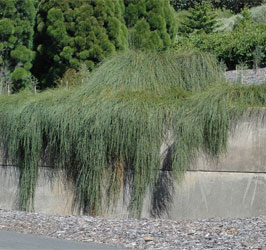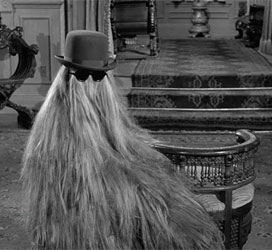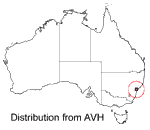Casuarina glauca prostrate forms
including Casuarina 'Cousin It'
 |
 The character 'Cousin Itt' from the TV series The Addams Family |
Casuarina glauca 'Cousin It' nom. cult.
Casuarinas are often called 'native pines' because their foliage bears a similarity to pine needles. Individual plants are either male or female, but unlike the conifers they bear resemblance to they are in fact true flowering plants. The Casuarinaceae family is native to Australia, southeast Asia and islands of the Pacific.
 Casuarina glauca is commonly called the 'Swamp Oak' due to the wood's oak-like appearance and natural occurrence near brackish waterways. Prostrate forms of this tree are known to occur naturally (many other coastal heath plants, such as Banksia, similarly produce prostrate forms).
Casuarina glauca is commonly called the 'Swamp Oak' due to the wood's oak-like appearance and natural occurrence near brackish waterways. Prostrate forms of this tree are known to occur naturally (many other coastal heath plants, such as Banksia, similarly produce prostrate forms).
One of these forms is a non-flowering curio originating at Bulli south of Sydney (see map left). The bark is grey-brown and scaly, with stems growing horizontally to mould over surfaces. The reason for its form and failure to produce flowers is unclear. This selected prostrate form of Casuarina glauca is being marketed as Casuarina 'Cousin It', strangely named from a character in the TV series 'The Addams Family' featuring a group of fictional characters created by American cartoonist Charles Addams. The series ran 1964-1966 and 1973-1975. The character's name was actually 'Cousin Itt' with two 't's.
Cuttings taken from prostrate plants near Booderee National Park in 1989 were established in Canberra's Australian National Botanic Gardens, covering the ground with dense spreading foliage and creating sanctuary for reptiles and invertebrates. The thick litter layer produced retains moisture, retards soil erosion and suppresses the germination of other species.
Elsewhere, these prostrate forms can create useful traps for wind-blown sand or salt and cultivated Casuarina glauca stems have been used in reasonably nutritious recipes for chicken feed!
The leaves, or 'teeth', of Casuarina are very small and form rings at intervals along the stems, which are the chlorophyll-containing and photosynthetic parts of the plant. Wax-covered and deeply grooved, they provide the plant with attributes to withstand drying environments, such as coastal heath.
Soil conditions from arid to waterlogged are tolerated and nitrogen availability is facilitated by Frankia species of soil bacteria. Soil pH between 6 - 8 seems to favour root nodule formation. Heavy frost can kill the top layers of the foliage but the stems reshoot readily in spring .
Pests may include fruit-emulating gall 'coccoids' and Cuckoo Spit scale in Queensland. Perna exposita is a hairy brown caterpillar that can ringbark stems with its feeding habits. They drop to the ground when disturbed, so beating the shrub to collect caterpillars for removal may be all that's required to control these pests in a garden setting.
The cascading forms of this plant are highly suitable for appreciation and containment in hanging baskets and planter boxes.
Text by Bobbie Hitchcock (2005 Student Botanical Intern) [updated 2013, and 2015]
Derivation of the name: Casuarina glauca 'Cousin It'Casuarina - is derived from the Malay “Kasuari” or “Cassowary” which refers to the likeness of the plant's thin drooping stems and leaves to the feathers of this great bird. glauca- from the Greek “glaukos” describes the blue-green colour of its foliage. 'Cousin It' - from the character 'Cousin Itt' in the TV series 'The Addams Family' |
References
El Lakany, E.H. (1991) Casuarina glauca: a hardy tree with many attributes. A quick guide to useful nitrogen fixing trees from around the world. NFT Highlights NFTA 91-05, July 1991.
Harden, G.J. (Editor) (1990) Flora of New South Wales, Volume 1. New South Wales University Press.
Jones, D. & Elliot, R. (1986) (Reprinted 1995). Pests, Diseases and Ailments of Australian Plants . Lothian.
Ramm Botanicals online catalogue, www.ramm.com.au/catalogue/item/10-casuarina/73-casuarina-cousin-it (viewed 2/4/2015)
Wilson, K.L. & Johnson, L.A.S. (1989) Flora of Australia, Volume 3: Hamamelidales to Casuarinales . Australian Government Publishing Service, Canberra.
Wrigley, JW. & Fagg, M. (2003) Australian Native Plants. 5th Edition. New Holland.
Wikipedia entry for 'The Addams Family' http://en.wikipedia.org/wiki/Addams_Family
![An Australian Government Initiative [logo]](/images/austgovt_brown_90px.gif)

